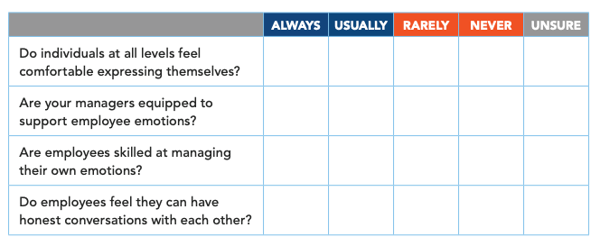

Emotions can run high when dealing with the day-to-day of work and life. Work can resemble a high-flying roller coaster at times. And employees may experience a wide variety of emotions ranging from disappointment and sadness to excitement and joy.
As Dale Carnegie, author of How to Win Friends and Influence People said, “When dealing with people, remember you are not dealing with creatures of logic, but creatures of emotion.”
As a manager, you’re not only regulating emotions as a result of stressful situations that happen at work—but outside of work too! People are complex and have a wide variety of needs. While supporting your employees’ emotional health might seem like the job of therapist, addressing emotions at work is crucial for your organization's success. The first step to create an emotionally safe work environment is to assess your emotional culture.
Emotional cultures are defined as the “shared affective values, norms, artifacts, and assumptions that govern which emotions people have and express at work and which ones they are better off suppressing.” While some organizations welcome emotions with open arms, others tend to ignore emotions at all costs. It’s important to discover where your organization lies on the spectrum and determine your action plan.
Ask your leadership team to reflect on these questions to uncover your opportunities for emotional growth.

If you marked mostly “Always” or “Usually” – great job! Your organization is doing a great job of creating a strong emotional culture for its employees.
If you marked mostly “Rarely” or “Never” – these are emotional culture red flags. Your organizational leaders should consider addressing these areas.
Pretend you are blowing up a balloon. As you add more air, eventually there won't be any more room for the balloon to expand, and the balloon will pop. This is what bottling up your emotions can look like. Imagine how that pressure might impact your employees!
Studies have found that keeping those emotions in can lead to a variety of health risks, including:
What were once emotions and feelings are now physical, health issues. The kinds of issues that affect your organization's productivity and ultimately, your bottom line. If individuals don’t know how to express their emotions well, they will likely feel uncomfortable and disengaged.
Encourage employees to focus on finding work-life balance. Strong emotional cultures understand work and personal lives are difficult to separate. Encourage your employees to find time to maximize all aspects of their personal well-being.
Our research found that change communication within large organizations has opportunity for improvement. When leadership fails to include employees on important issues, employees feel disconnected from their work and the organization. As a result, employees often don’t feel cared for as people and tend to participate in gossip.
Commit to participating in honest and direct conversations with every level of your organization. Provide a variety of opportunities for your employees to hear and respond to the changes happening at work. Invite employees to express their concerns during one-on-one meetings and have regular conversations with your direct reports.
Asking for feedback is a great way to uncover the reasons your employees are experiencing different emotions. Managers who know the importance of regularly connecting with employees – taking time to listen – are better positioned to address a problem before it gets worse.
When something feels off or a stressful situation arises, request feedback from employees at all levels. Doing so will allow your team to better cope with their emotions and express their concerns. Consider including relevant questions in your engagement and pulse surveys.
It’s important for the overall health and productivity of your organization (and everyone within it) to prioritize your emotional culture. Download our ebook, Emotions in the Workplace, to gain more insight into improving your emotional culture.
Published September 5, 2019 | Written By Jocelyn Stange